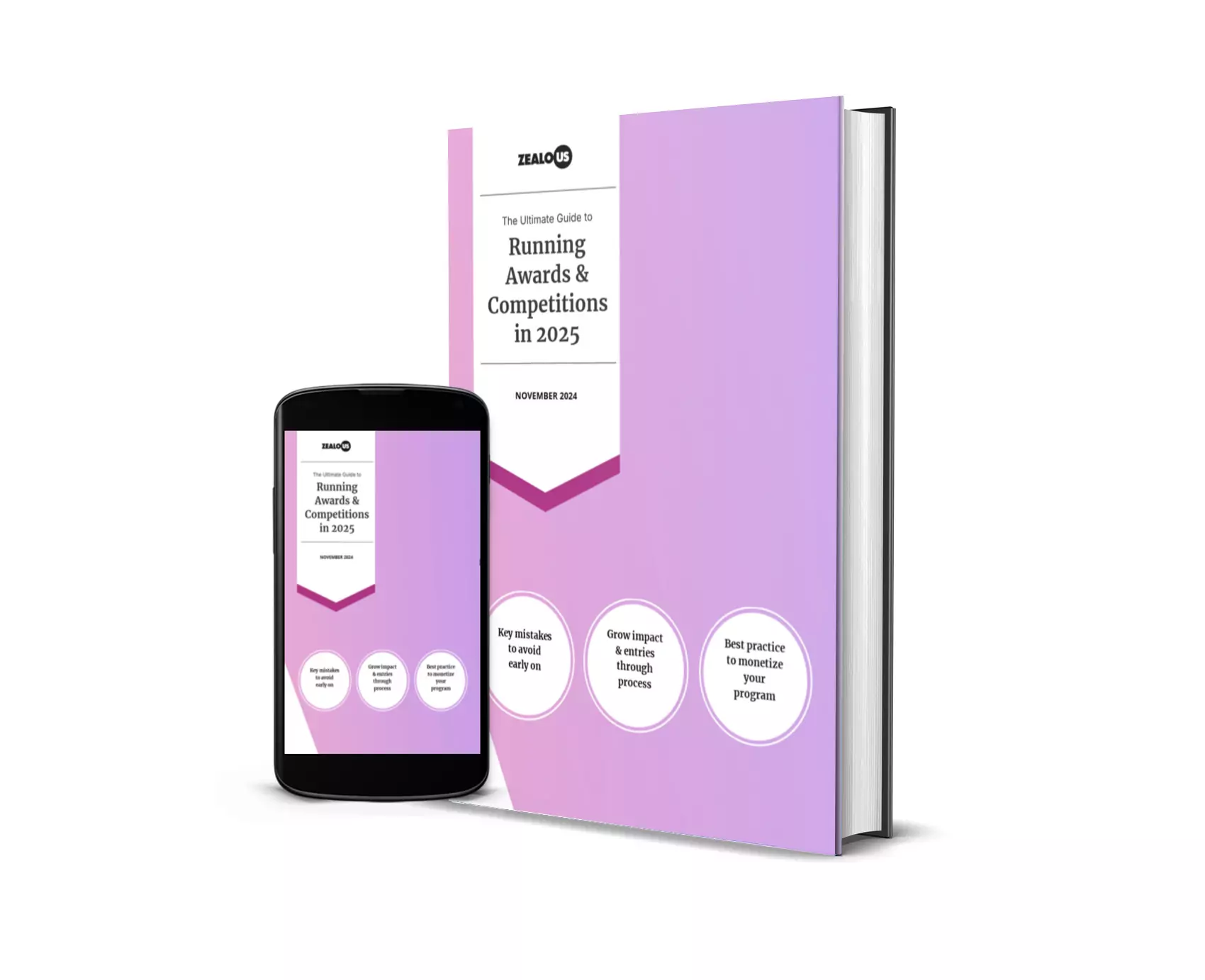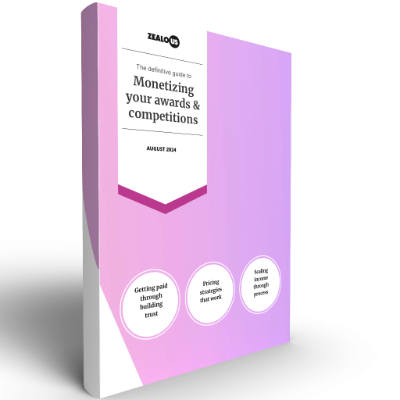This article covers:
- Why automation isn’t about replacing you
- Where automation actually saves your sanity
- Creating smooth candidate journeys with personal moments
- Making judging actually enjoyable
- Admin tasks automation handles completely
- When humans make the crucial difference
- Building trust through transparency
- The real cost of not automating
- Getting started without losing yourself
- Measuring what matters
Running an awards programme without automation? You’re probably spending more time on spreadsheets than celebrating great work.
Automation done wrong feels robotic. Candidates submit into a void. Judges get frustrated with clunky systems. Your programme loses the warmth that makes people want to participate.
The good news is you don’t have to choose between efficiency and empathy. The best awards programmes use automation to handle the tedious bits so you can focus on the human moments that matter.
Automation is about increasing impact (not people)
Let’s address the elephant in the room. When people hear “automation,” they picture cold, impersonal systems churning through applications. Nobody wants that.
Good automation is invisible to your participants. They just experience a smoother journey. Behind the scenes, automated systems handle the repetitive tasks that put more white hairs on your head (or in my case no hairs!).
Think about manually updating 300 applicants every time you extend a deadline. Or chasing twelve judges for their scores across three judging rounds. Or having to reformat 150 submissions so judges can actually review them. These tasks don’t require human judgment – they just require time, lots of it.
Quick calculation
If two team members each spend six hours weekly on admin tasks, that’s 288 hours over six months. At £25/hour, you’ve just spent £7,200 on repetitive work that could be automated (and that’s not counting time for training new team members on your manual processes, managing sick days and overheads of managing people).
Where automation saves your sanity
Some tasks automation handles brilliantly because they’re predictable and repetitive.
Timeline management tops the list. Set your dates once and submissions open automatically at midnight. Judging phases begin on schedule. Results publish when you’re ready. No more setting phone alarms to remember to flip switches on your website.
Professional communications run themselves. Confirmation emails send immediately when someone submits. Reminder emails go out three days before the deadline automatically (that’s when 50% of submissions typically arrive, by the way). Status updates keep everyone informed without you crafting individual messages to hundreds of people.
Payment processing becomes genuinely simple with payments made directly from the entry – no more make a payment here and we’ll email you the form. Entry fees go straight to your account. No manual invoicing, no chasing payments, no reconciling spreadsheets with your bank account at month-end.
Download launch checklist
Never miss a critical step: 300+ tasks across 8 phases, from securing judges to winner announcement.
Smooth systems build trust
Your candidates don’t care about your backend systems. They care about feeling like their work matters.
Automated submission handling means they can upload portfolios at 2am when inspiration strikes. Auto-save functionality means they won’t lose hours of work to a dodgy internet connection. Multi-device compatibility lets them start on desktop, finish on mobile. Whatever works best for them and gets you the information you need.
But automation should clear the path for human connection, not replace it. When someone asks a question about eligibility? That deserves a personal response from you, not a generic FAQ bot. When a candidate shares that they’re nervous about submitting? A genuine encouraging note from you matters infinitely more than an automated “good luck!” email.
If you automate the boring stuff, you have more time for the impactful human connection.
Zealous’s automated submissions management handles the technical heavy lifting – file uploads, form validation, payment processing. You focus on answering the meaningful questions and building relationships with your community.
When someone just misses the shortlist, a brief explanation shows you value their effort. These moments cost minutes but build loyalty for a life-time.
Making judging enjoyable (yes, really)
Want to know why judges ghost your awards programme? Terrible judging systems.
Give volunteer judges a clunky interface that requires constant clicking, unclear scoring criteria, or – worst of all – makes them download dozens of files to review work, and you’ll watch your completion rates plummet. Manually chasing twelve judges across three judging rounds consumes approximately 18 hours of your time. With automation, that drops to about two hours of actual oversight and meaningful dialog.
Intuitive judging matters
An intuitive scoring interface matters enormously. Zealous’s judging system lets judges score entries directly in browser on any device. Auto-navigation moves them smoothly from entry to entry. They can resume exactly where they left off. Images and videos display beautifully embedded. No external links or separate downloads required.
The human element is what judges crave and return year after year for. Personal invitations to serve (not bulk emails). Clear communication about time commitment upfront. Recognition for their expertise. A quick thank-you note when they finish.
Real-time progress tracking helps you identify who needs gentle encouragement. Automated reminders handle the basics, but when a respected judge hasn’t started with two days remaining, that deserves a personal phone call asking if everything’s alright with the timing.
Anonymous judging prevents bias, but personal check-ins during the process help judges feel supported rather than isolated. Some judges need reassurance they’re scoring fairly. Others want to discuss challenging evaluation decisions. Create space for those conversations.
The grunt admin work
Some tasks genuinely don’t need your personal involvement.
Bulk operations let you categorise multiple submissions simultaneously. Need to move 40 entries from longlist to shortlist? One click handles it. In manual systems, that’s 40 individual actions prone to mistakes.
Comprehensive data exports mean you can download submission details, judge scores, and custom reports instantly. Building email lists to update your community takes seconds, not hours of manual copying from various spreadsheets.
Live dashboards show submission numbers, judge completion rates, and programme performance in real time (no counting cells in spreadsheets!). Spot issues early without manually checking multiple sources. When you notice submission numbers dropping three days before deadline, you can pivot marketing efforts immediately.
Smart deadline management
Smart deadline management becomes properly useful. Decide to extend your deadline? Update it once and all participants get notified automatically. Your website, submission portal, and judge timeline all update seamlessly. The manual version of this takes 4-6 hours of updating multiple places and coordinating communications. Automated? About five minutes, and an email explaining why.
Want more articles like this?
Give this one a like
Humans make the crucial difference
Automation handles predictable patterns. Humans handle nuance, judgment, and empathy.
Eligibility questions often exist in grey areas. “I’m based in Manchester but work for a company headquartered in Germany—am I eligible for UK-focused categories?” This requires understanding your programme’s intent, not just checking boxes.
Conflict of interest decisions need human judgment. When a judge mentions they briefly collaborated with a candidate three years ago, is that a conflict? Depends on context automation can’t assess.
Exceptional circumstances arise constantly. A candidate’s grandmother passes away two days before deadline. A judge has an unexpected medical emergency mid-scoring. Technology can’t navigate these situations with appropriate compassion – but they can give you the toolset to make these communications easier (“I’m so sorry for your loss, I’ll send you a late-comer link so you can apply after the deadline”).
Automation will take you 95% of the way, but inclusivity only exists if a human is present to support where technology fails.
When things go wrong (and they will) human response matters enormously. Server issues on deadline day? Personal communication acknowledging the problem and extending grace builds trust. Automated systems keep running, but you provide reassurance.
Building trust through transparency
Automated systems often feel more trustworthy than manual ones when designed well.
Anonymous judging with visible scoring criteria creates fairness that candidates can see. Everyone follows the same process. Scores compile automatically based on clear methodology. There’s no room for accusations of favouritism when the system is transparent.
Data track every action. Who reviewed which entry when. What scores were assigned. When decisions were made. This documentation protects both you and your participants.
Real-time visibility helps everyone stay informed. Candidates can check submission status anytime. Judges see their progress relative to the panel. You monitor everything from one dashboard. Nobody’s left wondering what’s happening.
Be honest about automation’s limits
Transparency also means acknowledging automation’s limits. Tell candidates upfront when to expect personal responses versus automated confirmations. Let judges know which communications are automated and which come directly from you. Honesty about systems builds confidence.
The cost of not automating is higher than you think
Manual processes don’t just waste time, they can actively harm your programme’s growth and your team’s wellbeing.
Over 40% of workers spend at least a quarter of their work week on manual, repetitive tasks. For awards programmes, that’s often much higher. Track where your time actually goes during a programme cycle and you’ll probably find shocking inefficiencies.
Manual entry of 200 submissions at 10 minutes each consumes 33 hours. Ask the candidates to submit? Immediate, zero admin time. That’s nearly a full work week saved on a single programme element.
Errors multiply in manual systems
Errors multiply in manual systems. Copying email addresses from spreadsheets, updating multiple documents with same information, manually calculating scores across judges. Each action introduces potential mistakes. Research shows data accuracy increases by 88% when using workflow automation- higher than any other document processing method.
Hidden costs accumulate. When two team members each spend time on redundant manual coordination, you’re not just paying for task completion. You’re paying for mental overhead, context-switching, and error correction. You’re also paying the opportunity cost of what they could have accomplished instead (you’re also wasting their brilliant human mind on menial repetitive tasks).
Without automation, growth becomes genuinely frightening.
Doubling your submission numbers might mean doubling your team or working unsustainable hours (goodbye weekends!). Neither option is realistic long-term.
Insights like these straight to your inbox
Receive weekly tips from our founder to grow your program’s impact; regardless of what tools you use.
Getting started without losing yourself
You don’t need to automate everything immediately. Start with your biggest pain point.
If manually emailing updates to hundreds of people makes you dread every communication, begin there. Professional automated emails with your branding solve that problem quickly. You’ll save 8-12 hours per communication round while maintaining professional consistency.
If coordinating judges feels like herding cats, automated invitations, progress tracking, and deadline reminders will transform your life. Judges appreciate the gentle automated nudges, and you’ll appreciate not chasing people constantly.
If processing payments manually makes you want to quit, integrated payment processing eliminates that headache immediately. Zealous’s Stripe integration means entry fees go directly to your account – never held by the platform, no commission taken.
This evolutionary way works for a bit, but often it means creating solutions in silos (Google Form, Stripe, Mailchimp…). Each solution could itself cost money, which becomes expensive quickly. You’ll hit a point when you no longer need evolution, instead opting for revolution and a full submissions management platform.
Test thoroughly before going live
Test thoroughly before going live. Run yourself through the entire candidate journey. Have colleagues judge test entries. Break things intentionally to see what happens. Draft mode functionality lets you perfect everything privately before publishing.
The beautiful thing about good awards automation? It grows with you. Start with 50 submissions or scale to 5,000 without changing platforms or processes. Your workload won’t multiply proportionally with your programme’s success.
Measuring what matters
How do you know if automation is actually helping? Track meaningful metrics, not just vanity numbers.
Judge completion rates tell you if your judging experience works. If 90% of judges finish scoring, your system is working. If only 60% complete, something’s friction in the process (or perhaps you’re not providing enough human support).
Candidate satisfaction matters more than submission numbers. Are people recommending your programme to colleagues? Do previous participants return? These signal that your blend of automation and personal touch resonates.
Time saved should translate to better outcomes. If automation frees up 15 hours per programme, where does that time go? Into sourcing better judges? Improving marketing? Deepening relationships with your community? Make those hours count towards things only humans can do.
Error rates
Track how often you need to correct submission details, resend communications due to email errors, or recalculate scores. Fewer corrections means more time for strategic work.
Participation from underrepresented group
When your submission process works smoothly on any device, accepts files without as much as a quibble, and allows drafts to be saved and resumed, you remove barriers that disproportionately affect people with fewer resources, are less digitally savvy or have unstable internet access.
Finally
Awards automation isn’t about choosing between efficiency and empathy. It’s about using technology to handle predictable patterns so you can focus human energy where it genuinely matters.
Automate the tedious confirmation emails, the deadline reminders, the score compilation. Keep the meaningful responses, the strategic decisions, the community building human. Let systems smooth the path while you provide the personality that makes your programme special.
Your time is precious. Your participants’ time is precious. Automation respects that. Used well, it amplifies your humanity by making space for the moments that need your expertise, empathy and judgment.
The best awards programmes feel personal because automation removes the friction that prevents real connection.
- When candidates aren’t waiting days for basic updates, they’re free to engage meaningfully.
- When judges aren’t fighting clunky interfaces, they provide thoughtful evaluations.
- When you’re not drowning in admin, you can focus on creating impact.
We can help!
Zealous makes awards automation effortless
But we’re not alone in the space – here are 8 others you may wish to consider (even if we would prefer you choose us!).
Want us to write more content like this? Give it a like
Share

Guy Armitage is the founder of Zealous and author of “Everyone is Creative“. He is on a mission to amplify the world’s creative potential.
Frequently Asked Questions
Will automation make my awards programme feel impersonal?
Not when implemented thoughtfully. Good automation handles repetitive tasks invisibly while freeing you to focus on personal interactions that matter.
The key is using automation to smooth processes, not replace human judgment and empathy. When candidates receive timely updates and judges have intuitive interfaces, they experience professionalism—not coldness.
How much time can awards automation actually save?
For typical programmes, automation saves 10-20 hours per cycle on basic admin tasks alone. Manual processes like chasing judges, updating spreadsheets, and sending communications can consume 288 hours over six months for a two-person team. With automation, that drops to approximately 20-30 hours of actual oversight and strategic work.
What tasks should I never automate in an awards programme?
Never automate eligibility decisions that require nuance, conflict of interest assessments, exceptional circumstance responses, or programme positioning and messaging.
Personal responses to specific questions, acknowledgment of outstanding work, and crisis communication during technical issues all require your human judgment and empathy.
How do I know which automation features to implement first?
Start with your biggest pain point. If communication management takes the most time, begin with automated emails and updates.
If judge coordination causes stress, implement progress tracking and automated reminders. If payment processing is problematic, integrate payment systems first. You don’t need to automate everything at once—focus on what will provide immediate relief.
Can awards automation help with judge dropout rates?
Absolutely. Intuitive judging interfaces, clear progress tracking, and the ability to resume scoring on any device significantly improve completion rates. When judges can score entries seamlessly without downloading files or navigating confusing systems, they’re far more likely to finish. Combine this with personal check-ins for judges who haven’t started, and you’ll see dramatic improvements in completion rates.









